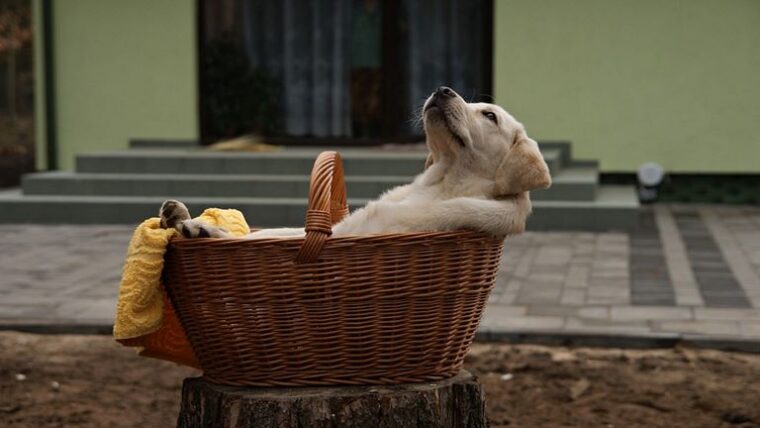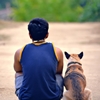Labs are known for their intelligence, loyalty, and trainability. They are considered one of the most popular dog breeds in the world, and for good reason. They are great with children, make excellent family pets, and are highly trainable. With the right training, a Labrador can learn a wide variety of tricks that will impress both you and your friends. In this blog, we will discuss 12 super impressive tricks your Labrador can learn.
Bow
Properly caring for a dog’s bow is essential to keeping them healthy and well-groomed. Tools such as bows, clippers, scissors, and brushes are all necessary components of responsible pet ownership; however the primary focus should be on cultivating an environment in which your pup feels safe and comfortable while wearing the bow.
First things first: it’s important to select a good fitting size of bow that best complements your pooch’ structure – be sure not to pick one too small or too large! Then you’ll want to properly secure it onto their head using either clips or elastics depending on if they have long or short fur. This can range from single pieces like top knots with cute accessory items linked throughout so each slot has its own style factor — making for exciting visuals we’re certain even cats would appreciate!
Lastly, but equally important – use quality grooming tools – extra attention needs to be paid when cutting nails, trimming pads, and face – think surgical precision applied only cautiously, just enough to take off the excess fuzz and ensure hygiene remains high while styling remains stylish.
High Five
Teaching your pup the “high five” trick is a terrific way to stimulate their minds and forge an even stronger bond between you both. Training them this command requires patience and consistency; luckily, these are skills dog owners already have in spades!
The process begins by arousing senses with fetch or tug-o-war playtime. Then use clicker training combined with verbal cues such as ‘up’ and/or ‘paw’ accompanied by treats further incentivizes the desired action of high fiving on command.
Gradually increasing difficulty can add upsurge of interest for pooch too until response comes easily on cue – clapping hands for approval encourages along journey towards mastery but remember do not overdo so pup does not become fatigued from repetition monotony .
With perseverance like any skill teaching it fully eventually happens just be sure when reward occurs afterwards enthusiasm needs remain uniformly encouraging toward continual progress!
Kiss
While many dog owners may assume that their pup’s smooch is simply an act of love or affection, a recent study has suggested the phenomenon might be more complex than it first seemed. A research suggests that Dogs can discriminate between human baseline and psychological stress conditions through odors allowing them to register whether they should feel secure or cautious around someone new.
When experienced with caution at first, gradually introducing your pooch to unfamiliar people using friendly licks could help build connection over time. In this process of tactile assurance, both parties will be assisted on their journey toward mutual trust and understanding.
Fetch & Give
Dog owners have long been on the search for efficient and effective training regimes that will help them reel in their canine’s wild nature. As a result, “fetch & give” is gaining popularity among pet enthusiasts as an accessible way of teaching lessons to pooches; it employs simple commands which can be gradually increased depending on how quickly dogs begin to learn complex categories.
Generally speaking, fetch & give involves a dog owner or trainer holding out either food treats or toys while issuing two distinct cues: “give me paw/give me five (which signify shaking hands) and “bring” (when retrieving objects).
By providing these consistent vocalizations during each task, pets are able to eliminate guesswork through repetition-based learning techniques more effectively than without such directions.
Additionally, eye contact should be maintained with the pup at all times so they know exactly what calls you expect from them. When combined correctly with verbal praise when our four-legged companion succeeds–the rewards cycle generally encourages faster comprehension!
All in all, this method advocates utilitarian behavior by conditioning animals back home after showing bad manners outside.
Sit Pretty
Teaching a dog to “sit pretty” is an achievable, yet impressive goal for any canine. By practicing positive reinforcement and reward-based methods; owners can encourage this trick with patience and consistency.
This feat of balance requires mastering several components such as keeping the tail still, push up form, upright torso posture and straight legs. Initially dogs may only be able to hold their position in short intervals but after lots of practice they will gain strength so that they are eventually capable of maintaining the sitting pretty stance longer periods over time.
When performing sit pretty it’s best if you command your pup verbally or gesture with two fingers pointing upwards at them while avoiding sudden movement which could startle them into tumbling down. Remember that training should always result in praise – otherwise progress can easily become demotivating!
With some dedication on behalf of owner and pet alike fantastic accomplishments like “sit on my knee bark three times” aren’t just possible but also delightful rewards from investing quality time together doing something creative.
Roll Over
As a Dog owner you should understand your Labrador’s behavior and It’s fair to say that most canine companions know when it’s time for a game of fetch; however, have you ever noticed your four-legged furball rolling over on command?
Rolling Over is a trick which can be taught relatively quickly and easily. To teach your pooch this manoeuvre using positive reinforcement methods, begin by having them lay down in front of you—try holding the treat out stretched towards their nose as an incentive if necessary.
Once they are laying comfortably then proceed onto making hand signals or speaking commands while gently prodding near their neck with pointing finger tips. This should induce them into turning over (or at least trying).
Ensure that each step provided has been fully completed before rewarding with verbal praises accordingly! With daily practice sessions conducted several times throughout the day, continuously re-enforcing tricks like Rolling Over will help enhance further obedience levels within any pup worth his/her pawful medal; so have some fun teaching him today!
Play Dead
‘Playing dead’, also known as ‘playing possum’ is a trick many dog owners can teach their furry friends. The main goal of teaching this command to your four-legged pal is for them to stay still and not move, even when they are excited or scared; thus greatly increasing safety in certain situations such as family parties, the presence of other animals etc..
Fortunately with time and patience any pet owner can achieve success while engaging in the task of helping Fido learn how to play dead. Start by forcing your Labrador into an awkward/uncomfortable position (belly up best works) then place treats nearby so eventually he will remain there without force being used due could connect that action and location with snacks which leads him wanting more!
Also add verbal commands along the way like ‘stay’ or ‘bang’: this reinforces ideas into his mind faster! Lastly don’t forget plenty praise each time progress has been made during training too!!
Carry a Basket
Carrying a bucket or basket while walking your dog is an often overlooked, but essential part of the daily ritual. Doing so increases your ability to store and transport items like dog treats; water bottles; blankets or towels in case of wet weather; waste bags for picking up after pup – all items that can facilitate safe and enjoyable walks with our furry friends. It also provides easy access when its time for some playtime!
In addition to being functional, buckets are great conversation starters by showcasing information about yourself through personalization options such as decorations, patterns, colors etc.. For example you could showcase creative artwork from local artists at pet-friendly parks/events/areas close to home which helps further connect people within their communities. And best yet it’s fun for both owners and canine companions alike!
Related:
What is the Ideal Labrador Weight?
Hug
Teaching your dog how to hug can be a fun and rewarding experience. To start, begin by teaching your dog the “Sit Pretty” command, as this will make it easier for them to understand the concept of the hug. Once your dog is comfortable with “Sit Pretty,” hold a treat close to your chest and encourage your dog to place their front paws on your chest to reach for the treat. As your dog becomes more comfortable with this position, use the command “hug” and reward them with praise and treats when they correctly place their paws on your chest.
Repeat this process regularly, gradually increasing the duration of the hug until your dog can hold the hug for several seconds. Remember to be patient, consistent, and use positive reinforcement to encourage your dog to learn this trick.
Spin
Spin, also known as canine freestyle, is a fun and unique way for dog owners to connect with their furry companions. At its core, spin relies on the dog’s natural behaviors combined with training from humans; by developing communication between pet and owner through music, agility obstacles (such as jumps), tricks and other commands set in time to an upbeat rhythm – it creates both a rewarding experience for the pup while providing joyful entertainment.
The symbiosis of this complex array of elements allows people to create exciting choreography that works best when there’s strong connection spanning emotions such trustworthiness; dedication; patience—all resulting in bonding moments enjoyed collaboratively by dogs’ humans affinities alike! Particular attention should be given toward safety cues like teaching verbal release words used if things become too overwhelming or challenging- which can always happen during extended sequences requiring perfect timing & rigorous repetition — so make sure you plan accordingly!
Jump
Dog owners can benefit from teaching their animals the important behavior of jumping. This skill not only provides a fun way to play and interact with your pet, but also serves numerous practical applications such as assisting in obstacle courses or dog agility competitions; it can even help when training dogs for service animal status. If you’re looking to improve communication between yourself and your pup, mastering regular jumps is an effective place to start – it takes a significant amount of focus and coordination on both sides, so having this physical exercise co-operated builds trust significantly faster than any verbal instruction alone would do so.
Furthermore; regularly practicing jump exercises will strengthen muscles throughout Fido’s body while simultaneously sharpening mind power due to increasingly difficult tasks over time – like progressing from short distances at low heights gradually up into more complex leaps across enjoyable terrain outdoors (which should be done under supervision). Training sessions must remain positive experiences that incorporate reward systems based upon desired goals achieved by one another through patience win ongoing support for everybody involved!
Stay
Every pet owner loves the phrase “stay” because it is a simple command that unleashes limitless potential for our four-legged friends; however, teaching your dog to stay can be an arduous task. But with patience and practice, you’ll soon have a well-trained pup who can reliably respond when commanded to stay in place.
The first step of this training process is developing their attention span by providing them with activities such as show commands or rewards within the same space whenever they look back at you after executing each move – always remember to reward them for good behavior! Once certain cues become reliable habits, slowly introduce distractions one by one until these are no longer necessary during sessions altogether.
In addition to practicing frequently without verbal prompts from outside sources like clickers or dogs toys/treats – which often detract focus not only from your pooch but also yourself – consistency is key: ensure that expectations remain clear throughout the journey even if progress appears slow initially.
With proper guidance and supervision while mastering basic obedience lessons along side advanced techniques tailored towards specific needs (such as dialing down hyperactivity), imparting ‘stay’ into their repertoire shouldn’t take too long before becoming second nature afterwards!
Key Takeaway
Whether you’re a first-time Labrador owner or an experienced pro, these 12 superb tricks are sure to impress your family and friends. With practice and lots of encouragement from their owners, Labs can learn all sorts of impressive behavior that will make them stand out among the crowd. So take some time to teach your Labrador pup one (or more) of these amazing tricks today!


